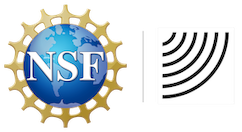LIGO's Impact on Science and Technology
Gravitational wave detectors like that of the U.S. National Science Foundation Laser Interferometer Gravitational-wave Observatory (NSF LIGO) will answer some outstanding questions related to gravitation and astrophysics, such as:
- Is general relativity the correct theory of gravity?
- How does matter behave under extreme densities and pressures?
- How abundant are stellar-mass black holes?
- What is the central engine driving gamma ray bursts?
- What happens when a massive star collapses?
NSF LIGO will also directly engage the scientific community in “multi-messenger astronomy,” a collaborative effort in which gravitational wave detectors and various kinds of telescopes (observing with electromagnetic radiation such as visible light, x-rays, gamma rays, radio waves, etc.), and even neutrino detectors observe astronomical sources at the same time. Each method of observing provides a different look at the same objects or phenomena allowing them to be studied in multiple ways from multiple perspectives, and revealing relationships and interactions never before observed.
Through its advances in technology and scientific methods, LIGO also contributes to other fields of science and to the broader technology enterprise.
LIGO and Astronomy
Detecting gravitational waves benefits greatly from observations by multiple detectors in widely separated sites. While LIGO itself comprises two detectors 3000 km apart, to enhance detection capabilities, it works closely with and observes alongside the Virgo detector in Italy and the KAGRA detector in Japan. Together, these research groups and detectors make up the LIGO-Virgo-KAGRA collaboration (LVK). The GEO600 detector in Germany serves the LVK as a testbed to help develop advanced interferometer and optical suspension systems for use in future detectors.
In the next decade, a third LIGO detector located in India will join in the search for gravitational waves. For years, LIGO staff have been training Indian engineers to prepare for this facility, expected to be completed in 2030.
Detecting gravitational waves isn't the only contribution to science LIGO wants to make, however. The next natural step in the evolving field of gravitational wave astronomy is to delve into the nature, dynamics, and structure of gravitational-wave sources. Exploring this realm requires that electromagnetic (EM) astronomers get a chance to observe and analyze any light coming from source objects (gravitational waves are completely distinct from electromagnetic radiation, so the sources of gravitational waves are usually invisible to telescopes). To that end, LIGO partners with Earth-based and orbiting observatories that also search the skies for a glimmer of light resulting from a gravitational-wave causing event.
Less than two years after LIGO's first detection of gravitational waves, this momentous 'next step' was taken. On August 17, 2017, LIGO detected a gravitational wave (GW170817) from what seemed to be a source never-before seen in its detectors. Combining their data, LIGO and Virgo quickly localized the region of sky from which this signal emerged. This information was shared with LIGO's EM partners (over 90-strong by the summer of 2017) and within hours, an optical telescope in Chile became the first ever to observe the clearly visible aftermath of what is now known to have been a collision of two neutron stars! For the first time, LIGO's and Virgo's gravitational-wave sensors enabled EM astronomers to directly observe a powerful gravitational-wave generator within hours of its occurrence. Optical, x-ray, radio, infrared, and gamma ray telescopes, as well as neutrino detectors all subsequently participated in post-GW170817 observations. To date, GW170817 is believed to be the most widely studied single astronomical event in human history.
The rewards to the EM astronomical community that come with following-up LIGO detections are only beginning to be realized, and the potential for discovery is undeniable. This growing field of ‘multi-messenger’ astronomy represents one of the largest collaborations that LIGO and other detectors will help to facilitate amongst the global scientific community. LIGO is at the heart of this new scientific endeavor, which promises to be extremely fruitful for all involved.
LIGO's Impact on the Broader Scientific and Technical Community
LIGO’s impact (and the impact of its sister facilities) reaches far beyond physics, astrophysics, and astronomy. The effort to design and build detectors like LIGO and to understand the characteristics of the expected gravitational-wave signals have resulted in multiple scientific and technological applications and advancements in many fields like those listed in the table below.
| Technology category | Technology advanced or invented by LIGO |
|---|---|
|
Impact of gravitational-wave science on other fields |
|
LIGO's impact on technology advancement and invention has expanded beyond astronomy and astrophysics. Several other fields are benefiting from LIGO's development. The Gravitational Waves International Committee (GWIC) document, “The future of gravitational wave astronomy: A global plan”, describes some of these other benefits.
Scientists and engineers in these other fields are already benefitting and will continue to benefit from advances gravitational wave detector technology and data analysis methods developed by LIGO.
Transfer of LIGO Technology Developments to the Broader Technology Enterprise
LIGO has already spawned innovative technology and invention. Innovations in areas as diverse as lasers, optics, metrology, vacuum technology, chemical bonding, and software algorithm development have resulted directly from LIGO’s pioneering work. Some of these ‘spin-off’ technologies are listed in the table below. More about each one can be found on the Technology Transfer page.
| Technology category | Technology advanced or invented by LIGO |
|---|---|
| High-performance optics and optical metrology | Photo-thermal interferometer |
| Optical components |
|
| Lasers |
|
| Ultrahigh vacuum components and techniques | Vacuum cable clamp |
| Sensor technology | Interferometric displacement sensor |
| Materials engineering | Oxide bonding techniques |
| Computation and time-series data analysis | Fast chirp transform |
| Computation and data analysis | Blind data search method |
| Distributed computing | Distributed identity management |



